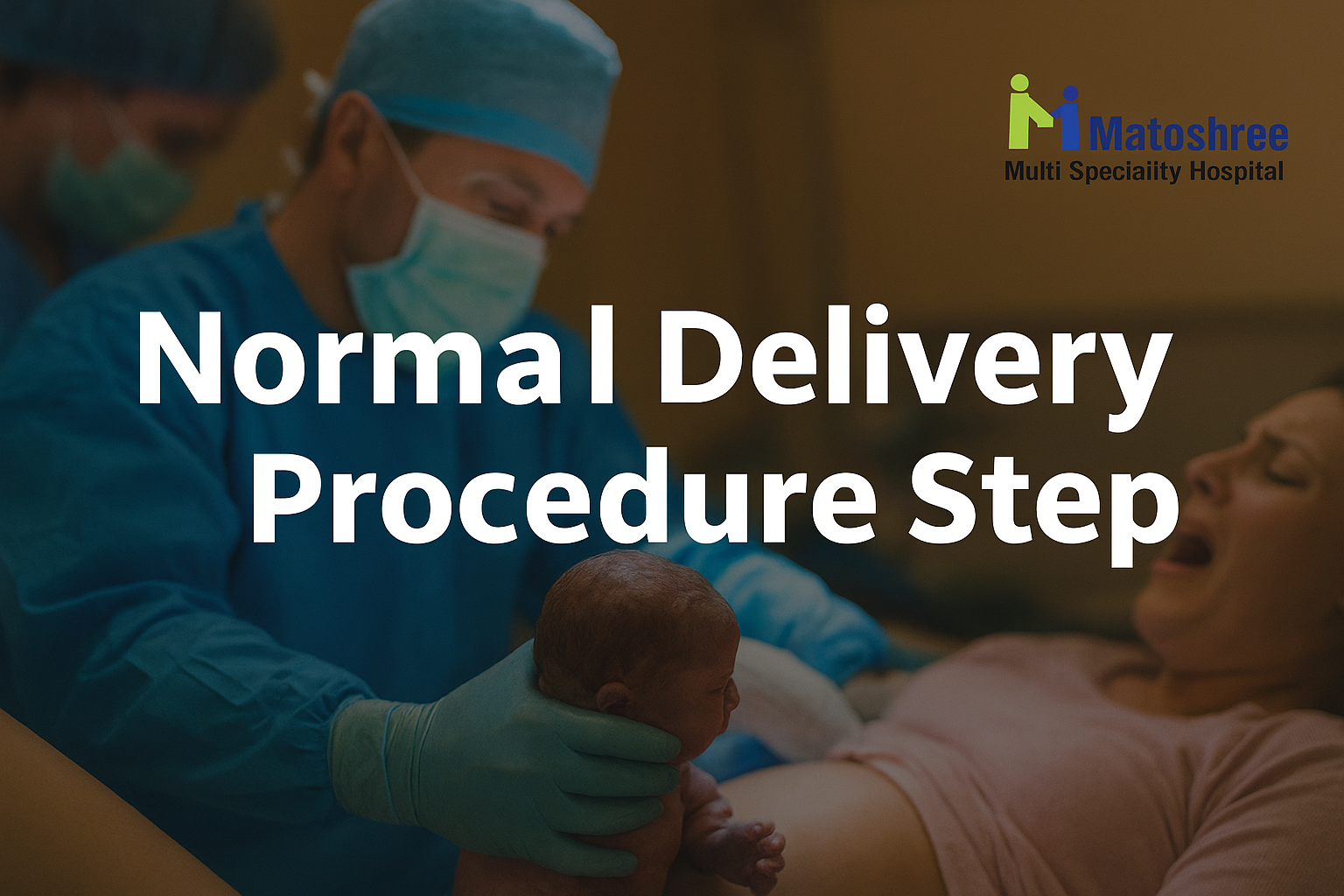Normal Delivery Procedure Step by Step: Understanding the Normal Delivery Process

Introduction
Expectant mothers, their partners, and their birth support teams should all know the normal delivery process step by step. Knowing the normal delivery process well can help you feel less anxious, get ready better, and have a smoother birth. This article explains the stages of normal delivery, what happens in each phase, and how you can prepare for a positive birthing experience.
What is a Normal Delivery?
A vaginal delivery, also called a normal delivery, is when a baby is born naturally through the birth canal without any surgery.When both the mother and the baby are healthy, this is thought to be the safest and most natural way to give birth. The benefits of normal delivery include:
- Faster recovery time
- Lower risk of infection
- Early skin-to-skin contact and breastfeeding
- Shorter hospital stay
Pre-Labour Signs: The Body’s Preparation
Before labour begins, your body goes through changes indicating that the normal delivery process is approaching. These include:
- Lightening: Baby drops lower into the pelvis.
- Braxton Hicks contractions: Mild, irregular contractions that prepare the uterus.
- Cervical changes: The cervix softens and begins to open.
- Loss of the mucus plug: A discharge that shows labour may be near.
These are signs that your body is preparing for the next stage — active labour.
Stage 1: Labour – Cervical Dilation and Effacement
This is the first major stage of the normal delivery procedure step by step. It begins with regular contractions that help the cervix open up to 10 cm.
Early (Latent) Labour
- The cervix dilates from 0 to 6 cm.
- Contractions are mild and irregular.
- Lasts several hours to a day for first-time mothers.
- Activities like walking, light eating, and relaxation help.
Active Labour
- Cervix dilates from 6 cm to 10 cm.
- Contractions become stronger, longer, and more frequent.
- Breathing exercises, massages, and supportive birthing positions can help manage pain.
Transition Phase
- The cervix is fully open (10 cm).
- The contractions are very strong and happen very close together.
- The urge to push starts, which means it's time for the next step in a normal delivery.
Step 2: Pushing and giving birth to the baby
When the cervix is fully open, the mother starts to push during contractions to help the baby move through the birth canal.
What Happens
- The baby's head comes out (crowning).
- After the head comes out, the shoulders and body follow.
- Skin-to-skin contact and breastfeeding right away are good ideas.
Length
- First-time moms may push for as long as three hours.
- Mothers who have given birth before may not have to push for as long.
- Changing positions, deep breathing, and relaxation can help make this stage more comfortable.
Stage 3: Delivery of the Placenta and Post-Labour Care
The last step in a normal delivery is to deliver the placenta and start taking care of the baby after birth.
Placenta Delivery
- The uterus contracts to push out the placenta.
- This usually happens within 30 minutes after birth.
- We check the placenta to make sure it has come out completely.
Care After Labor:
- If there are any tears, they are sewn up.
- They keep an eye on the mother's vital signs.
- The baby is dried off, warmed up, and put on the mother's chest.
- Breastfeeding is good for uterine contractions and bonding.
Tips for a Smooth Normal Delivery Process
- Attend antenatal classes to learn breathing and relaxation techniques.
- As recommended, do light exercise and yoga while pregnant to stay active.
- Eat well and drink enough water.
- Make a birth plan and talk to your doctor about it.
- Stay calm and look for early signs of labor.
When the Normal Delivery Process May Need Help
Sometimes, a normal delivery may need help because of problems like:
- Labour not moving forward
- Fetal distress
- The baby is not in the right position (breech, transverse)
- Problems with the placenta or too much bleeding.
Doctors may use medical treatments or do a C-section to keep both the mother and the baby safe in these situations.
FAQs About Normal Delivery
1. What is the average duration of normal delivery?
For first-time mothers, normal delivery may take between 8 to 14 hours. For women who have given birth before, it usually takes less time.
2. How painful is normal delivery?
Pain varies from woman to woman. Breathing techniques, position changes, and epidural anesthesia (if needed) can help manage pain effectively.
3. Can I choose to have a normal delivery?
Yes, if your pregnancy is low-risk and your doctor confirms it’s safe, you can plan for a normal delivery.
4. What helps to increase chances of normal delivery?
Regular exercise, good nutrition, avoiding stress, and attending prenatal classes can all improve the chances of a normal delivery.
5. What should I pack for hospital delivery?
Include essentials like ID, insurance documents, baby clothes, nursing bras, sanitary pads, comfortable clothes, and snacks.
6. Is it safe to have a normal delivery after a C-section (VBAC)?
In many cases, yes—under medical supervision. Your doctor will evaluate your health, previous C-section scar, and baby’s condition before approving a VBAC (Vaginal Birth After Cesarean).
Conclusion
The step-by-step procedure involved in normal delivery is one of the natural and empowering ways through which a mother brings life into the world safely and confidently. Getting to know the steps involved in the normal delivery procedure allows a mother to plan for childbirth physically and mentally.
If you are pregnant and seeking expert advice for safe maternity care, it would be ideal to visit a long-serving gynecologist in Kamothe.Your pregnancy will be followed up by a qualified gynecologist who will offer you individualized care and lead you through all the stages involved in delivering a baby so that the birth will be smooth and healthy.





















 (1).png)